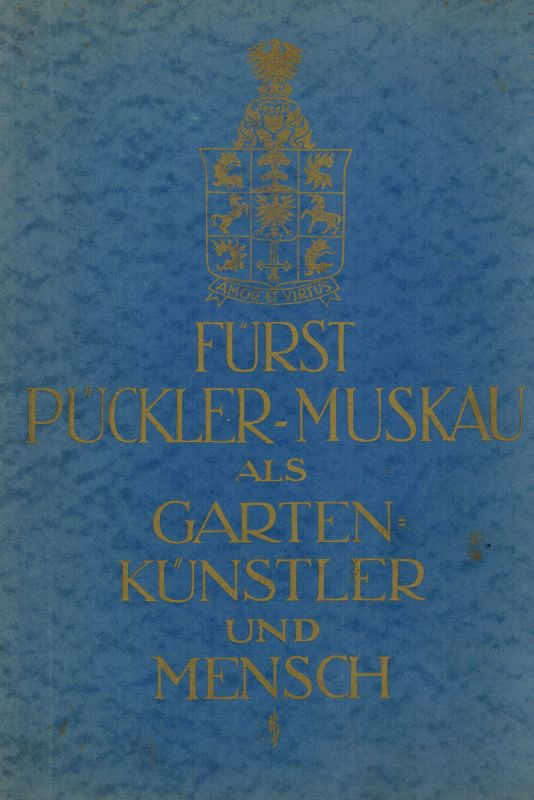[Pückler-Muskau, Fürst Pückler als Gartenkünstler und Mensch.
Fürst Pückler als Gartenkünstler und Mensch. [German edition of a book on Count Pückler-Muskau as Garden Design Artist, his time in Ireland and Britain etc.]. von Gartenbaudirektor Fritz Zahn.
Cottbus, Verlag Albert Heine, 1928. 29,5 cm x 21,5 cm. 212 Seiten mit zahlreichen Farb- und Schwarzweißabbildungen / 212 pages with numerous Illustrations. Original Hardcover. Sehr guter Zustand mit nur geringen Gebrauchsspuren. Selten in diesem guten Zustand !
Enthält u.a.: Pücklers Entwicklung zum Gartenkünstler durch Studium der Natur und vorhandener Parkanlagen / Pücklers weitere gartenkünstlerische Tätigkeit / Fürst Hermann von Pückler als Mensch / Auf der Wanderung durch Abendland und Morgenland etc etc.
Prince Hermann Ludwig Heinrich von Pückler-Muskau; born as Count Pückler, from 1822 Prince; 30 October 1785 – 4 February 1871) was a German nobleman, renowned as an accomplished artist in landscape gardening, as well as the author of a number of books mainly centering around his travels in Europe and Northern Africa, published under the pen name of “Semilasso”.
Pückler-Muskau was the first of five children of Count Carl Ludwig Hans Erdmann Pückler, and the Countess Clementine of Callenberg, who gave birth to him at age 15. He was born at Muskau Castle (now Bad Muskau) in Upper Lusatia, then ruled by the Electorate of Saxony. He served for some time in the Saxon “Garde du Corps” cavalry regiment at Dresden, and afterwards traveled through France and Italy, often by foot. In 1811, after the death of his father, he inherited the Standesherrschaft (barony) of Muskau. Joining the war of liberation against Napoleon I of France, he left Muskau under the General Inspectorate of his friend, the writer and composer Leopold Schefer. As an officer under the Duke of Saxe-Weimar he distinguished himself in the field. Later, he was made military and civil governor of Bruges.
After the war he retired from the army and toured Great Britain, for a year, moving with ease in aristocratic circles. He attended plays at His Majesty’s Theatre, Haymarket and Drury Lane (admiring performances of Eliza O’Neill), studied parkland landscaping, and in Wales visited the Ladies of Llangollen in 1828. In 1822, in compensation for certain privileges which he resigned, he was raised to the rank of “Fürst”[1] by King Frederick William III of Prussia. In 1817 he had married the Dowager Countess Lucie von Pappenheim, née von Hardenberg, daughter of Prussian statesman Prince Karl August von Hardenberg; the marriage was legally dissolved after nine years, in 1826, though they did not separate and remained on amicable terms.
Mahbuba, ca. 1840
He returned to England in 1828 where he became something of a celebrity in London society spending nearly two years in search of a wealthy second wife capable of funding his ambitious gardening schemes. In 1828 his tours took him to Ireland, notably to the seat of Daniel O’Connell in Kerry. On his return home he published a not entirely frank account of his time in England. The book was an enormous success in Germany, and also caused a great stir when it appeared in English as Tour of a German Prince (1831–32).
Pueckler’s name carved in the Great Enclosure of Musawwarat
Being a daring character, he subsequently traveled in Algeria, Tunisia, Egypt and Sudan and explored ancient Nubia. He is documented as having visiting the site of Naqa in modern-day Sudan in 1837. He also visited the nearby site of Musawwarat es-Sufra, and in both places he carved his name in the stone of the temples. In the same year, at the slave market of Cairo he purchased an Ethiopian Oromo girl in her early teens whom he named Mahbuba (″the beloved”). He took her to Asia Minor, Greece, and Vienna, where he introduced her to European high society, but Mahbuba developed tuberculosis and died in Muskau in 1840. Later he would write that she was “the being I loved most of all the world.″
He then lived at Berlin and Muskau, where he spent much time in cultivating and improving the still existing Muskau Park. In 1845 he sold this estate, and, although he afterwards lived from time to time at various places in Germany and Italy, his principal residence became Schloss Branitz near Cottbus, where he laid out another splendid park.
Politically he was a liberal, supporting the Prussian reforms of Freiherr vom Stein. This, together with his pantheism and his colourful lifestyle, made him slightly suspect in the society of the Biedermeier period.
In 1863 he was made a hereditary member of the Prussian House of Lords, and in 1866 he attended — by then an octogenarian — the Prussian general staff in the Austro-Prussian War. He was decorated for his ‘actions’ at the Battle of Königgratz, even though the then 80-year old Prince had slept throughout the day.
In 1871 he died at Branitz. Since human cremation was illegal at that time for religious reasons, he resorted to an ingenious evasion of traditional burial; he left instructions that his heart be dissolved in sulphuric acid, and that his body should be embedded in caustic soda, caustic potash, and caustic lime. Thus on February 9, 1871, his denatured remains were buried in the Tumulus – an earth pyramid surrounded by a parkland lake at Branitzer Castle.
Dying childless, the castle and estate passed to the heir to the Princely title, his nephew Heinrich von Pueckler, with money and the inventory to his niece Marie von Pachelbl-Gehag, née von Seydewitz. The literary estate of the Prince was inherited by writer Ludmilla Assing, who wrote his biography and posthumously published correspondence and diaries unpublished during his lifetime. (Wikipedia)
Hermann Ludwig Heinrich von Pückler-Muskau (* 30. Oktober 1785 auf Schloss Muskau; † 4. Februar 1871 auf Schloss Branitz bei Cottbus) war ein preußischer Standesherr, Generalleutnant, Landschaftsarchitekt, Schriftsteller und Weltreisender (sein Pseudonym als Autor und Reisender: „Der Verstorbene“ oder „Semilasso“) und seinerzeit ein bekanntes Mitglied der gehobenen Gesellschaft.
Unter Kennern gilt er als landschaftskünstlerisches Genie, seine Weiterentwicklung des „englischen Parks“ in den Landschaftsparks von Muskau (Fürst-Pückler-Park Bad Muskau) und Branitz wird nicht selten sogar über Lenné und Sckell gestellt. Beide Parks und die seiner Schüler (besonders Eduard Petzolds, 1815–91) machten international bis nach Nordamerika Schule [4] und zählen bis heute zu den besonderen Höhepunkten der Landschaftsgestaltung im 19. Jahrhundert in Europa.
Was beide Parks besonders kostspielig machte, war der Umstand, dass Pückler für ihre Anlage riesige Mengen Mutterboden aus weiter entfernten Gegenden auf Ochsenkarren heranschaffen ließ, da der sandige Untergrund für den geplanten Bewuchs ungeeignet war. Darüber hinaus gelang es ihm erstmals, ausgewachsene Bäume zu verpflanzen. Er ließ sie auf einem speziellen Fuhrwerk heranfahren und den Boden am neuen Standort „baumgerecht“ präparieren. So gelang es ihm, sein berühmt gewordenes Konzept der „Blickachsen“ schon bei der Anlage der Parks zu verwirklichen.
Pückler, der seine Möglichkeiten der Besichtigung des englischen Landhauses und den Zutritt zu den Gartenanlagen in England zum Teil nur persönlich zugebilligt erhalten hatte und zu schätzen wusste, beschloss den freien Zugang für seine Landschaftsgärten und weitete ihn auf jedermann aus. (Wikipedia).
- Keywords: Art · Catalogue Four – International Art · Garden · Garden Architecture · Garden Design · Garden Design – Rare · Pückler-Muskau in Ireland
- Language: Deutsch
- Inventory Number: 70916AB
EUR 80,--
© 2025 Inanna Rare Books Ltd. | Powered by HESCOM-Software










